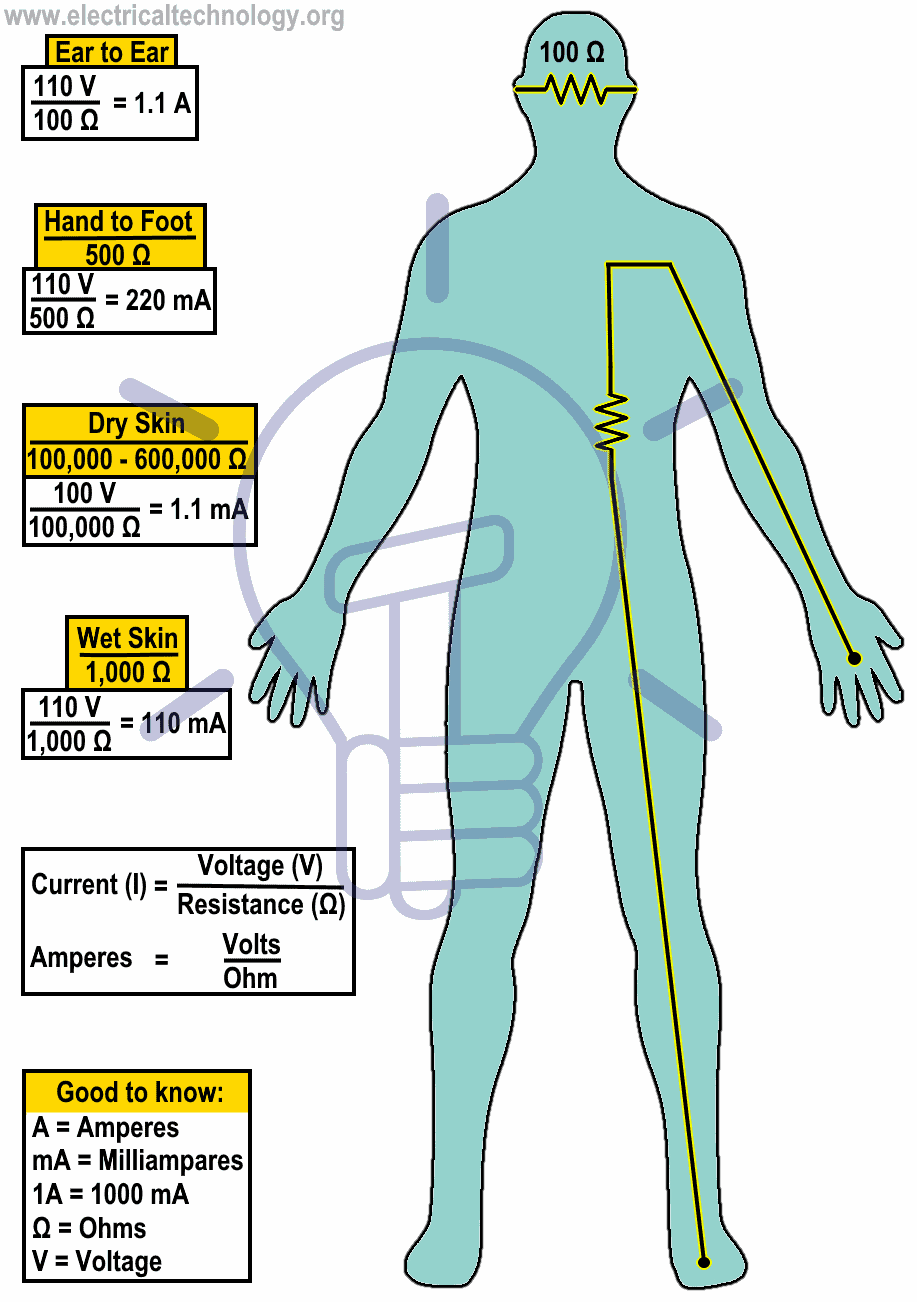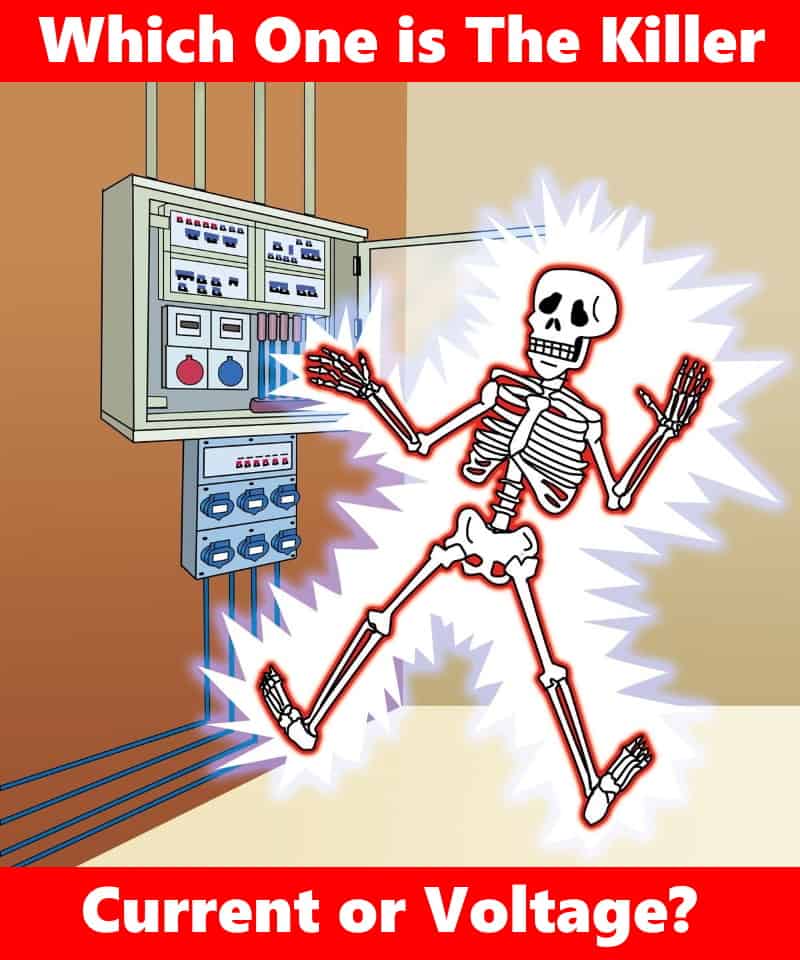Which One Kills – Current or Voltage and Why? Amps vs Volts
Which One is the Fatal, Voltage or Current and Why?
A bad wife or girlfriend won’t kill you, but voltage and current can do so easily at a certain level. That’s why no one should play with electricity (power, voltage, and current) because it can be our friend, but it can also be our worst enemy. If we give it a chance, it will not hesitate to strike.
Before we go in details, I will ask another question. If I kill you with a knife (don’t worry, I won’t but not guaranteed), will you blame the knife or me? Another way, Which is the killer, bullet or gunpowder?. Related to the topic, Which is the killer, Current or Voltage?
Before we delve into the details, I have another question. If I were to harm you with a knife (don’t worry, I won’t, and there’s no guarantee of it happening), would you blame the knife or me? Similarly bullet or gunpowder?, when it comes to the topic at hand, which is the true ‘killer’ current or voltage?
To know the exact reason, we must know the difference between Current and Voltage. As explained in the previous post, voltage is the cause and current is the effect.
- Voltage: is the potential difference (a type a force) between two points which causes current to flow in the circuit. It is the force required to move the amount of energy from one point to another.
- Current: is the rate of charge flow (electrons) between two points caused by voltage. Voltage is the main cause to push the electrons through a conductor or completed electric circuit.
Related Posta:
- AC or DC – Which One is More Dangerous And Why ?
- What Happens When an AC Line Touches a DC Line?
- Difference between AC and DC (Current Voltage)
To know which is the fatal, voltage or current? Let’s see the following formulas.
- V = I x R … (Ohm’s Law)
- P = V x I … (Power in DC circuits)
- P = V x I x Cosθ … (Power in AC single phase AC circuits)
Where:
- V = Voltage in Volts
- I = Current in Amperes
- R = Resistance in Ohm’s
- P = Electric Power in Watts
- Cosϕ = Power factor
As the first formula (or Ohm’s law) shows that voltage is must to flow the current in a conductive material having some amount of resistance as almost all materials having some amount of resistance to the flow of electrons through it.
At the other hand, In I = V / R, current is directly proportional to the voltage, but current is inversely proportional to the voltage in P = VI?
The logic behind this scenario is that some of the quantities remain the same in the first case, while parameters change in the second case. Assuming that the resistance is constant, then:
- If the power of the source is constant, the current decreases when voltage increases.
- If the power of the source increases, both voltage and current increase, meaning the power is variable.
Related Posts:
- Why Can’t We Store AC in Batteries instead of DC?
- Which One is More Dangerous? 120V or 230V and Why?
- Which One is More Dangerous? 50Hz or 60Hz in 120V/230V?
So the main cause is the voltage and current as an effect is the killer at specific rate for specified period. Current will kill you but some amount of voltage is required to flow that current in the body breaking the human body resistance. In other words, an enough power is required to pass in the human body for proper electric shock.
In short, high voltage with a few micro amperes cause nothing to the human body like in high voltage supplying cathode ray tube in traditional TV set or high static voltage in the comb. on the other hand high current with hundredth of ampere with ten, twenty or thirty or more make nothing to human bodies like electric welding machine as the amount of voltage is not enough to push that level of high current in the human body as there is a path with least amount of resistance as compared to the human body internal resistance. Another example is the car battery having high amperage with low voltage level (12V DC) but if we touch both leads, it won’t electrocute. Therefore enough voltage of hundredth with enough current make electric shock to human bodies because human body like resistor need enough power to pass current.
Related Posts:
- Why Don’t Birds and Squirrels Get Electrocuted on Power Lines?
- Why Do Electronic Circuits Use DC Current instead of AC?
- Difference between AC and DC Transmission System
Keep in mind that the effects of electrical current through the human body vary according to:
- The value of the current
- The value of the voltage
- The time the current flows through human body
- The frequency of the supply (50Hz / 60Hz or more / low)
- The pathway of the current (dry, wet etc.)
- The ability of the person to react (nerve system)
The following level of voltage are considered safe.
AC Voltage
- 25V (Wet places)
- 50V (Dry places)
DC Voltage
- 120V DC
The following tables shows the different values of AC and DC currents in mA and its effect on the human body. Keep in mind that it is the average value and not meant to be same for everyone as it depends on different factors.
| AC in mA (50Hz) | DC in mA | Effects on Human Body |
| 0.5 – 1.5 | 0.4 | Perception |
| 1.3 | 4 – 15 | Surprise |
| 3 – 22 | 15 – 88 | Let’s Go (Reflex Action) |
| 22 – 40 | 80 – 160 | Muscular Inhibition |
| 40 – 100 | 160 – 300 | Respiratory Block |
| More than 100 | More than 300 | Usually Fatal |

Related Post:
- Is Lightning AC or DC ?
- Why Can’t a 12V Car Battery Electrocute You?
- What Happens if a Battery is Connected to the AC Supply?
Conclusion about the confusion of which one is hazardous, Current or Voltage?: Current Kills, Not the Voltage. But Voltage is must to drive the Current. I.e. Amperes are responsible for electrocution, Not the Volts.
Warning: Both AC and DC voltages and currents are dangerous. Don’t touch the live wires. In case of electric shock and hazardous effects, try to disconnect the power supply and push back the victim body from the source (keep in mind that you should properly insulated before doing so). Only call the professional and licensed electrician in case of repairing or troubleshooting. In case of emergency, call the local authority for medical help ASAP.
Related Articles:
- Why are “High Voltage” Signs used when Only Current Kills?
- Electrical Shock Hazards & Its Effects on Human Body
- Why Earth Pin is Thicker and Longer in a 3-Pin Plug?
- Why Do Prongs in Electrical Plugs Have Holes in Them?
- Difference Between Grounding, Earthing and Bonding
- Why are US Homes Wired Using Solid Wire rather than Stranded Wire?
- Why are Outlets and Receptacles in Hospitals Upside Down?
- What are the Different Colors Electrical Outlets Used for?
- Why Does the Heating Element Glow but Not the Cord of Heater?
- Why are Stones Laid in an Electrical Substation?
- Why a Transformer Can’t be Operated on DC Supply?
- What happens if You Connect a 3-Φ Induction Motor to 1-Phase Supply?
- Why are Salt and Charcoal Added in Earthing Pit for Grounding?
- What Happens to the Battery with Reverse Polarity Wiring Connection
- Why is the Grounding Wire Bare and Not Insulated?
- How Many Amps Will Flow in a Short Circuit Powered by a 120V, 20A Breaker?
- Why AC Needs More Insulation Than DC at Same Voltage Level?
- What are the Tiny Cylinder in Power Cords & Cable?
- Protective Actions to Avoid & to Reduce Electric Hazardous
- Personal Protective Equipment (PPE) for Electrical Works
- All About Electrical Protection Systems, Devices And Units
- Basic Electrical & Electronics Interview Questions & Answers
- 65+ Basic Electronics Engineering Interview Questions & Answers








16mA to hurt, 60mA to injure, but only 6mA across the heart to kill.
Remember: 16-60-6 sixteen sixty six
You should tell the people that the grounding earth and the grounded is the neutral. You are very confusing here also mention how it completes the circuit Electricity is always looking for aground and you do not want to be it
There is a half amp in a heart beat and that is all it will take to kill you if it flows through your heat (current). You are DEAD. CALL AN ELECTRICIAN
Best post
Educative!
Voltage
This is a foolish question. Current itself is due to voltage difference. If no voltage difference, no current will flow. When current flow through the body, person feel the shohk
It is the current, that causes the i njury.
Sure current is caused by the Voltage. In the presence if Voltage you ca control the current, by increasing the resistance to earth. If you use highly insulated shoes you will get small or no shock. You might have seen birds sitiing on Ht wires , with Voltage level of 22000 to 220,000 Volts without getting hurt, because there is no connection with the ground or other wires.
Both current and voltage can kill. Voltage cannot flow without current. Current cannot flow without voltage. Resistance persist this method and this depends.
Which one can kill man? Pistol or bullet?
Good question, but very confusing. I think both can kill the same time
It depends on resistance between body and ground.
tunjiadewale2006@gmail.com
Both are related by Ohms law
V is proportional to current and the constant of proportionality is R or resistance. This is important. So when I stand on a wooden platform and touch a live wire I can acquire the high voltage but not get killed because there is no current flow. But current can’t exist without voltage. But voltage alone can’t kill. One can conclude that V is a ne necessary condition but not a sufficient condition. But current is a sufficient condition.
wow so current is the bullet and voltage is the gunpowder!!!! so funny
Hi
I am Not à specialist but I remember from my study It s the frequency the problem. 50 hrz Block thé heart pulsations.
You were *almost* at the correct answer when you stated “The time the current flows through human body”
Three ingredients are necessary to kill : voltage, current, and time.
Remember that P (power) = I (current) x V (voltage), but that power is measured in Watts, which is derived from E (energy, measured in joules) per T (time, in seconds), or P = E/T. Therefore, E = P x T, or
E = I x V x T
so, the answer is that *energy is what kills you*, not voltage alone, and not current alone. And current is not “primarily responsible” for the effect, as one other commenter suggested. It’s energy.
QED